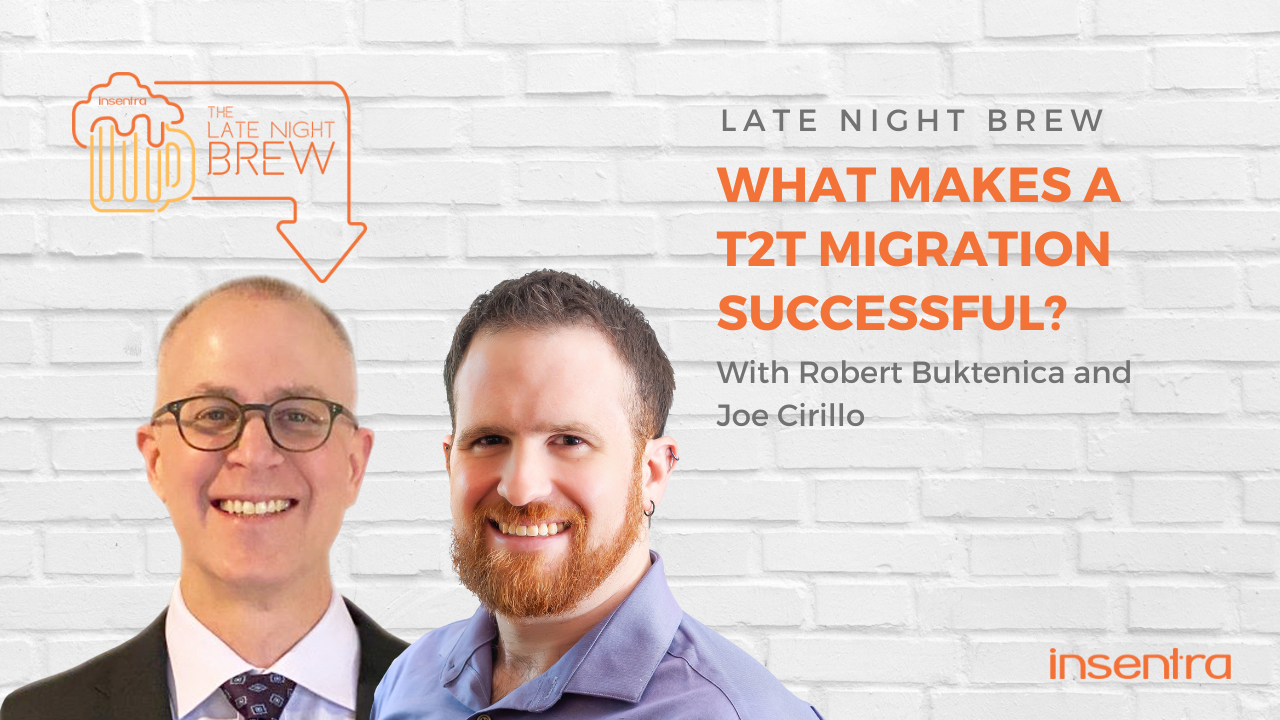Welcome to the second episode of Late Night Brew: Tenant-to-Tenant! Robert Bucktenica and Joe Cirillo are back. This time, they’re diving deep into the three most important metrics of a successful T2T migration. They also provide tips on how you can ensure your migration project achieves these success factors.
Grab your choice of brew and hang out with us as we unravel the secrets behind a successful T2T migration.
TIMESTAMP
00:07 – Introduction
00:40 – The Brew
01:39 – What are the top three measures of a successful tenant-to-tenant migration?
04:15 – How do you ensure these are successful?
TRANSCRIPT
Introduction
Robert Buktenica: Hello, everybody, and welcome to another episode of the Late Night Brew, where we talk the brews first and then we get around what we’re supposed to eventually. Joining me, once again, on this next episode of the tenant to tenant series, Joe, welcome back, buddy.
Joe Cirillo: Thank you, Sir, for having me here today.
Robert: Clearly, you pregamed.
Joe: Clearly, totally prepared for this.
The Brew
Robert: Before we dive into what it is that makes a tenant to tenant successful, you, of course, know the drill, Sir, what brew are you enjoying with me today?
Joe: Today, I’m going extremely kid-friendly. I got my Country Time flavoured lemonade drink. Not even real lemonade, so, in a pouch. That is my brew for today, and it’s … I will say.
Robert: The most satisfying part is getting the straw in, right?
Joe: Yes, that’s about it. It’s definitely flavoured artificial.
Robert: Well, today, I have Isolation Ale, more of a winter brew. And since it is below 70 for once, again, in Phoenix, it’s a nice almost to the season, even though it’s supposed to be snowy in January.
Joe: Indeed.
What are the top three measures of a successful tenant-to-tenant migration?
Robert: All right, on that terrible note of me griping about the weather, yet again, what are the most important, maybe top three measures of a successful tenant-to tenant migration?
Joe: Absolutely. Number one, first and foremost, is end user experience, right?
Robert: Right.
Joe: If you’re doing a migration, and at the end of the day, the end user feels like it was a migration, then it was probably not a great experience. But if you can make the migration experience for them seem as fairly seamless as possible—it’s never going to be completely seamless. There’s always going to be a little bit of pain involved because you have to touch the endpoint at some point.
But again, from an end user experience perspective, that’s definitely key and foremost in any migration.
Robert: Low impact, I think that’s how we usually phrase it.
Joe: Yes, absolutely, low impact. The other one too is just minimal disruption to how they work. As well as maybe if you have customers that you’re hosting certain things for, too, minimal disruption both to the end user and to the customer.
If an end user is used to a certain way of working in the old tenant, you want to make sure that as part of that transition, you’re not affecting that as well. Maybe, even maybe, improving their productivity and collaboration in the new tenant in some feature and functionality. But for the most part, yes, it’s another big key as far as the success is; minimal disruption to how the actual user is doing their work.
The last one, really, is just more about accessibility. When you think about you and your email for a certain period of time throughout the day, when you do a transition like this, you want to make sure that you still have your email accessible even through the transition.
There’s always a little period of downtime, of course, but at the same time, the user can still maintain access to their email in the old tenant, like through the web browser and such, while the transition’s going on. And then, usually, afterwards, after the migration, they’ll have access to it.
Even if they don’t have a media access with the mobile device setup, like the Outlook client setup, again, they have the browser access and the ability to go in through the web to access their email. That’s another key component as well from a successful factor, is just accessibility throughout the migration.
How do you ensure these are successful?
Robert: Right, right, got to make sure. Now, that’s of course a lot. It sounds incredibly simple, we’ll be like “Yes, let’s just make sure user experience is good, no big deal.” How is it that we’re able to ensure, or you’re able to ensure that these are successful, on top of making sure the migration’s successful?
Joe: I mean, obviously, having the right tool is key but the most critical piece is the communications plan for the end users, right? How are you going to communicate what is occurring as part of the migration. The typical, what they call the five Ws with the H, who, what, where, when, why and how?
When you’re communicating to the end user community, you have to basically communicate out who’s going to be affected, what’s changing for them.
Specifically too, if you’re going to a different licensing scheme, or so forth, that’s a big part of it, and where can they go for more information, right? Are you publishing it on an intranet, part of the website, FAQs, all those things.
Of course, when. So, when’s the time it will occur, because a lot of these are big bang over a particular weekend. Sometimes you do phase, depending on the scale. Of course, communicating when a particular group of users, that’s a big part of it.
Why. People often want to know, “Why are we doing this? I like the way I’m working right now. Why do I have to change?” Hopefully, you’ve addressed the why and give them some information around that.
Lastly, how it will occur. You really want to be prescriptive in explaining how things are going to happen for them. There’s basically no surprises when it comes to before and after.
Robert: That really goes in with the successful ends with like the accessibility of “This is all that you need to know, this is where you’re going or this is where you will—or you’re missing something, here’s how you can report this, this is how you can see if it’s in the old one, right?” That type of thing.
I think communication should be tacked into that top four now because I think we’ve all been in the game long enough and we know communication is easy in theory.
Joe: Absolutely. One thing I was taught as a trainer is when you’re teaching adults is you really want to first explain to them what you’re going to do, and then basically walk them through it, and then at the end to recap. I think that’s a good procedure or process for a tenant migration as well, right?
You really want to get upfront and explain all the Ws, what you’re going to do, why and all those things. And then, basically, get them through that, and then afterwards it’s always good to recap and see how the migration went as well.
Robert: Right.
Joe: That feedback is critical.
Robert: That’s the real hot tip of the episode. We end on a high note, I’m going to say. We’re out of time there. Joe, thank you, as always. It’s a pleasure and I’m looking forward to the next episode on this series.
Joe: Absolutely, great. Thanks, Buck, talk to you soon.
Robert: Definitely, if there’s any questions, please reach out, our contact information’s below. Until then, take care.
Missed the first episode? Explore our complete video series on Tenant-to-Tenant to catch up on what you’ve missed. Ready to delve deeper into T2T? Download the A Comprehensive Guide to Microsoft 365 Tenant Migrations now!
If you have any questions or require expert assistance, you can explore our MapTo Advisory Services or reach out to us and we’ll get in touch with you.











